Having left Morocco, the Zuiderdam now heads northward into Europe with an ambitious itinerary of 14 ports in 18 days. We’ve been spoiled with the luxurious cadence of having ample sea days in which to rest, plan and catch up on travelogues in between ports. While we passengers are certainly not complaining, we will have to muster some stamina to keep up with the pace (and calories!) of wonderful Europe. With that said, you may notice shorter narration and more photos. And why not…as they say, a picture is worth a thousand words!
Passing through the Straights of Gibraltar during the night, we were alongside the dock in Malaga, Spain before sunrise. This beautiful, ancient city of 600,000 in the south of Spain was founded some 3,000 years ago.

Beyond the inviting coastline beaches, there is a labyrinth of narrow passages, lovely balconies, and artistic granite/marble streets that lead you to plenty of majestic cathedrals.

The El Teatro Romano is the oldest monument in Málaga, dates back to the 1st Century and is situated at the foot of the famous Alcazaba fortress.

Calle Marqués de Larios, commissioned in 1880 is their popular pedestrian shopping street; a hive of activity on this 70-degree afternoon.


And the day wouldn’t be complete without sampling some of the Iberian Ham that can be found everywhere, as well as creatively displayed!

Interesting fact: An antipode of any place on the Earth is the place that is diametrically opposite it, so a line drawn from the one to the other passes through the center of Earth and forms a true diameter. Malaga, Spain and Auckland, New Zealand are antipodes of each other, and both visited on this voyage.

Next, Cadiz, Spain welcomed us on Easter Sunday, with balconies throughout the city adorned in red cloth to symbolize the blood of Christ. In fact, Semana Santa (Holy Week) is the most important religious holiday of the year in Spain. Annually between Palm Sunday and Easter Sunday, every town in Spain celebrates and elaborate daily processions reenacting the Passion of Jesus Christ.

The 1-kilometer procession of uniformed marching brass bands and the heavy, elaborate float depicting Christ departs at one church, passes through narrow streets and small plazas until it enters another church on the other side of town. Perhaps as their own form of penance, dozens of men shouldered the heavily decorated platforms, and marched slowly and steadily for hours to the end of the parade route.



At 8am the Zuiderdam turns from the Atlantic Ocean and makes her way up the Targus River to dock in Lisbon, Portugal. Along the way, we view Belem Tower, the Discoveries Monument, Bridge of 24 April and finally to our berth at the base of the El Farma neighborhood by 10am.
We have a beautiful sunny day of 70 degrees in the forecast to walk to the Baixa Mercado, but are disappointed to find it not open on Mondays, depleting us from the extraordinary ham and cheese sandwich that we experienced here in 2019. A visit to Pastiella de Nata for a creamy custard tart would have to suffice as a substitute.



After our 4 mile walk about around town, we returned to the ship for a quick rest before a group of us returned ashore to celebrate shipmate Trevan’s birthday!


Underway for one sea day of nearly 400 miles, we arrive in A Coruna, Spain.

As it was still early morning and much of Spain doesn’t get going until midday, we hopped aboard a bus that would give us a broad overview of nearly every attraction in this city of 235,000 people. The ancient fort, Hercules Tower which is the world’s oldest operating lighthouse and World Heritage Site, the Mosaic Octopus and San Pedro Mount, a former military base giving us spectacular views of the rugged coastline.



The skies cleared in the afternoon, and we took the opportunity to walk the old section of town and share some nice local wine with friends.

That evening, the Captain announced a change to our itinerary. A low-pressure system was forecasted to affect our planned route through the Bay of Biscay and, to avoid the strong weather system, they made the necessary decision to cancel our next day’s call to Brest, France, and instead make a last-minute deviation to the port of Portland, England, visiting the adjacent town of Weymouth.
Weymouth, England (The Port of Portland) While this port of call was not originally scheduled, it was a delightful surprise! The Old Harbour section of town is very quaint.

And then you turn the corner to the other side of the narrow peninsula, and the broad Esplanade and wide pebbly beach rolls out an enchanting shoreline rimmed with beautiful and often ornate hotel facades and eateries. Warm sun but otherwise cool.
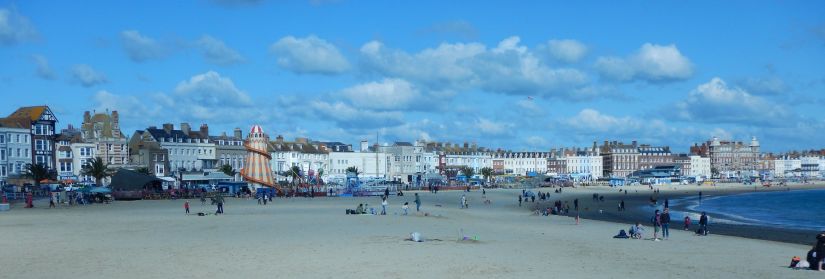

The afternoon found us at The Sailors Return pub with a friendly bunch of locals that welcomed us into their fold, and we enjoyed laughs, stories and photos. They taught us a fun pool game called Killer, playing with all yellow and red balls. Thanks to Eloise, Chelsea, John, Roger and others for all the belly laughs!

It turns out that our next intended port will also suffer a last-minute deviation. This time due to labor strikes instead of weather. The port of LeHarve, France was cancelled due to national protests over the country’s pension bill reform. The quick replacement was announced as Dover, England.
Just across the English Channel from France, the 350-foot high white cliffs of Dover are stunning as we enter the port. It’s a hazy 58 degrees with a light breeze.

Spring has sprung here, with the flowering trees and young green grass scenting the air. We opt to discover the two thousand years of history at Dover Castle. Henry II built the present castle in the 1180’s, and over the next 800 years it was adapted to meet the changing demands of weapons and warfare.

The 80-acre site includes the Roman Pharos, Saxon Church, 12th century Great Tower and WWII hospital, command center and secret tunnels that were still used until 1958.


The sprawling estate demonstrates the extraordinary feat of ancient construction capabilities. It’s difficult to comprehend how they achieved their buildings and moats!

We went subterranean into the wartime tunnels that served as an underground hospital and command center for the 1940 evacuation of troops from Dunkirk. Sorry, photographs were not allowed, but suffice to say, it was quite a moving experience to walk the cramped, dark confines and imagine the danger and tension of those days.

Zuiderdam sails a mere 58 miles north of Dover to the Port of Zeebrugge, and gateway to Bruges, Belgium. This charming, picturesque town of 118,000 is famous for its canals, medieval buildings, waffles, chocolate, beer and….a French Fry Museum. We went on the hunt for all of them!



We also strolled amongst more bricks than one would think are on the planet. Roads, buildings, walls, sidewalks; everything. We shared Chimay Beer (thank you, Monks, for your fine brewing expertise!) with shipmate friends.



This small city is huge on personality and worth a longer stay. We will be back someday!

Amsterdam, The Netherlands There is no better way to view Amsterdam than from a canal boat. And better still, when friends invite you to join them on a lovely private, pristine boat built in 1900, “Terra-Nova”.

Every highlight of the city parades by as we ply the narrow canals; the leaning buildings, Opera House, bikes, houseboats, tulips, etc.
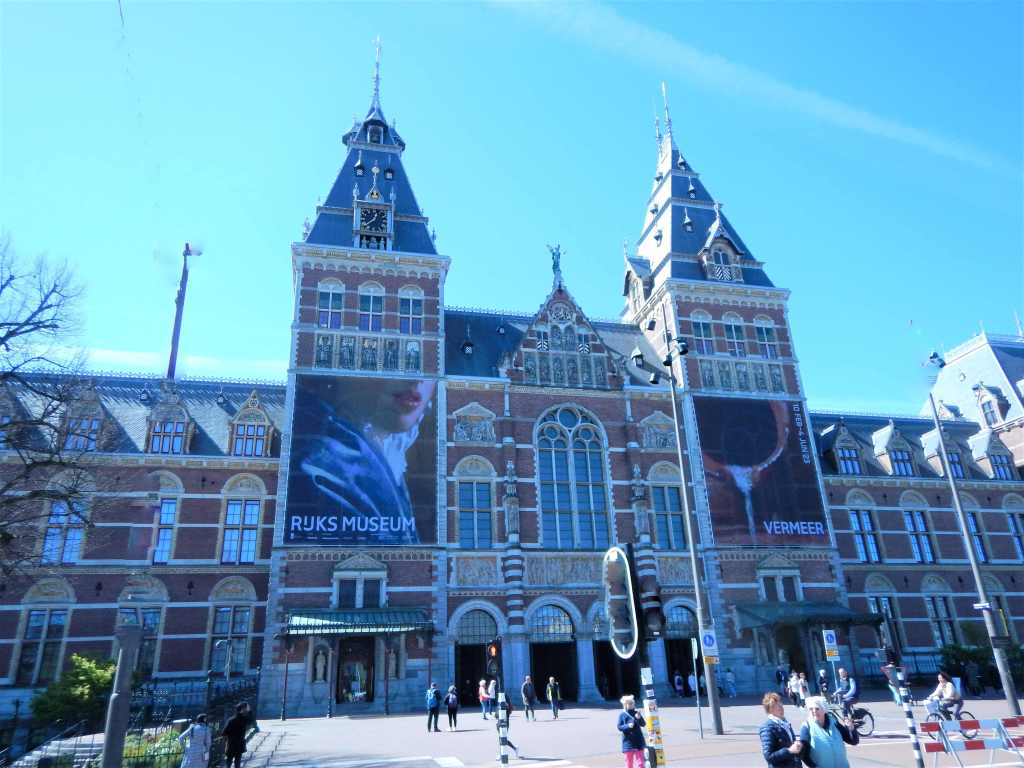
We disembark Terra Nova at the Riks Museum, for a short walk to the oldest Indonesian restaurant in Amsterdam, for a traditional Dutch luncheon called rijsttafel. The exact origins of rijsttafel are thought to have originated in the Dutch East Indies (present-day Indonesia) during the Dutch colonial period. The word literally means “rice table” and features a wide variety of Indonesian side dishes served with rice. Nearly every inch of the table has a bowl, platter or tray of food and we happily wined and dined for hours. It was an absolutely beautiful and unforgettable day with a great group of friends!




Onward to Copenhagen, Denmark, where we rode on a Hop On/Hop Off bus to get a broad view of this capital city, home to 1.5 million people.
One of Copenhagen’s many charms is its harborside location and multitude of canals. The most iconic spot in Copenhagen is Nyhavn harbor, known for its colorful 18th-century buildings and tall ships. Walking along the promenade and admiring Cophenhagen’s waterfront is delightful. We also discovered that Denmark is renowned for being expensive. Our two cappuccinos with an accompanying tart cost $30!


No visit to Copenhagen would be complete without seeing the iconic Little Mermaid statue on the harbor. As well as the impressive Opera House, the Gefion Fountain and Christianborg Palace.


Copenhagen’s Strøget is one of the longest pedestrian shopping streets in the world, stretching for close to a mile. Shopping options here range from souvenir stalls, chain stores and international designer brands. All at top prices.

Oslo, Norway – Norway is known for its Scandinavian design, architecture, and statues at every turn. Even the Oslo Town Hall interior features the most impressive large-scale murals we’ve ever seen. It’s a gorgeous Spring day, and since it’s a Saturday, we actually get to see locals at their leisure. Many streets were closed in preparation for a marathon race, as well as three festivals in town. Combine that with 3 cruise ships in port, it turned into a festive block party in every direction: from the fort to downtown and its fantastic waterfront promenade.

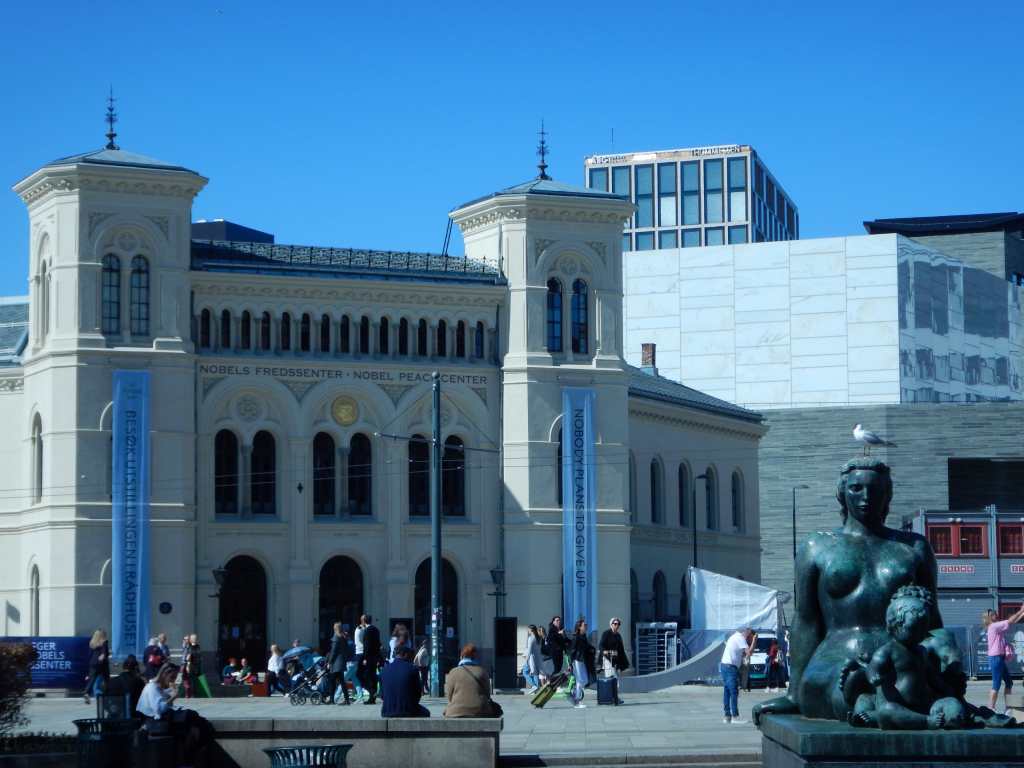



Kristiansand, Norway is a small coastal town, with a population of 112,000. As our route continues northward, the temperatures have dropped, and we strike out to explore on a cloudy 45-degree morning.

Our 6-mile walk across cobblestone streets took us from the Otan River to Old Town where the historical white cottages are found. We strolled Markens pedestrian shopping street, quiet on a Sunday morning.


By afternoon, the sun peeked through, warming to a high of 58 degrees. We came upon the picturesque Domkirke Cathedral in the town square, with its copper verdigris patina shimmering in the sunlight. Lovely statues and fountains were found everywhere.

Haugesund, Norway is found in the Karmsundet Sound on the North Sea. Its location is ideal for the company, Aibel, who design, build and maintain oil, gas and wind facilities worldwide, and a major employer in this city of 35,000. Their massive platform constructions are impressive. Here’s a glimpse of their work: https://vimeo.com/727376515

On a cloudy, misty 45-degree morning, we walk over the Risoy Bridge into a quiet town.

While there was an abundance of remodeling and refurbishing in this charming town, the place was fairly deserted.
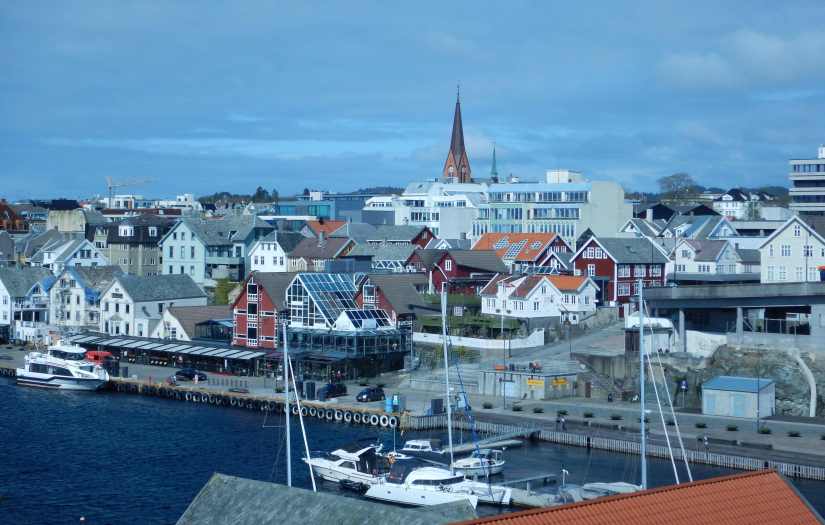
Quiet parks where spring growth was still sparse on the trees.


Back aboard the ship, our Captain informs that we will have higher winds tonight, but we’ll be sheltered in the fiords for the next 100 miles, as we make our way towards Eidfjord for a 7am arrival.
Eidfjord sits at the innermost part of the Hardangerfjorden in Western Norway. This tiny hamlet of several hundred people is such a peaceful place. The still waters reflect the magnificent fjord landscapes featuring green mountain sides, snowy white tops and silver waterfalls.
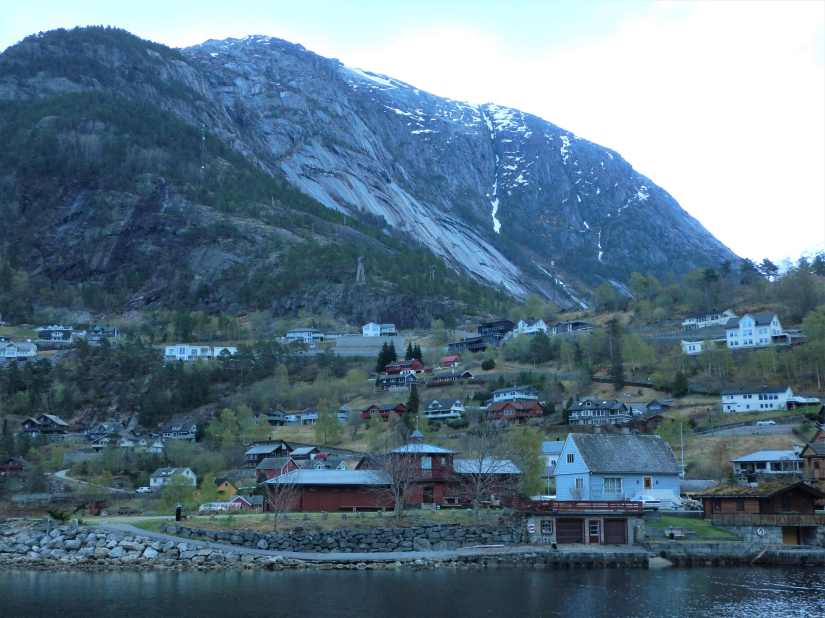
After strolling the village, we took the high path to find 2 churches, graveyards, and one school. Coffee shops and a few souvenir shops completed our tour.



Welcome to Bergen, Norway, where we experienced four seasons of weather in each hour; rain, sun, sleet and snow. Our walk began on the peninsula where we found the Fredriksberg Fortress, Aquarium and the beautiful Nykirken Church overlooking the harbor.

The Fish Market along the waterfront offers interesting gastronomic specialties, including sausages made from whale, reindeer and moose. One of the most photographed panoramas are the colorful buildings of Bryggen on Bergen’s waterfront, where we sampled a “Caputo” coffee; similar to cappuccino.

In the back street neighborhood, we found the funicular, and the most stuffed antique shop we’ve ever seen. A wonderful pizza lunch with red wine in a cozy café with fireplace warmed us up on this chilly day.



The m.s. Zuiderdam now turns away from Europe, sailing southwest 425 miles for the United Kingdom. Stay tuned.

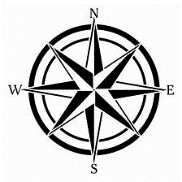

Absolutely stunning. Thanks for sharing your travel log!
LikeLike
Spectacular photos and narrative, as usual, is informative and interesting.
LikeLike
Does your brain ever explode from the absorption of the abundant dining,culture, history and fun that you,and Tom,
are immersed into,during your travels?
Wayne
LikeLike
Hahaha….yes! This big blue planet is indeed a fascinating kaleidoscope of languages, customs, cuisines and scenery. It’s a privilege to continue learning all about it!
LikeLike